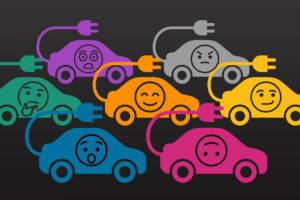Energy
What can we learn from the emotional ride of electric vehicle advertising?
 Despite what anyone may say, the future of electric vehicles (EVs) is going to be bold. Volvo announced that from 2030 onward it will only produce EVs. Volkswagen set the same goal for 2033, GM for 2035, Toyota for 2040. The EV switch is an exciting transformation, but is the timeline realistic? Automakers are scaling back ambitious production forecasts now as demand softens. At the same time, the industry needs to overcome two hurdles in order for EVs to actually be a viable option for consumers: its lack of infrastructure and the initial price of an EV. Overcoming them seems a long way off.
Despite what anyone may say, the future of electric vehicles (EVs) is going to be bold. Volvo announced that from 2030 onward it will only produce EVs. Volkswagen set the same goal for 2033, GM for 2035, Toyota for 2040. The EV switch is an exciting transformation, but is the timeline realistic? Automakers are scaling back ambitious production forecasts now as demand softens. At the same time, the industry needs to overcome two hurdles in order for EVs to actually be a viable option for consumers: its lack of infrastructure and the initial price of an EV. Overcoming them seems a long way off.
So, how can car makers sell this new wave of transportation today, despite the hurdles? Enter their marketing and creative teams. We looked at 2022 and 2023 TV commercials for electric cars for a clue of what’s to come and discovered that EV creatives are ahead of the game. The main lesson we learned: you need to put emotions in the driver seat.
Volvo
Volvo’s ads focus on selling confidence and trust in its hybrid vehicles. In Volvo’s July 2022 ad “The Chase,” you go on an emotional journey with a father who’s trying to get through his hectic day where everything is on low battery. Volvo compares the need to constantly charge your car with constantly charging the other electronics that make our lives easier but run out of battery life. The exception to the father’s low-battery devices is his car – a hybrid. The ad’s tagline is “Electric Cars with a Backup Plan.” Volvo is clearly acknowledging the current lack of charging ports for cars and offers the hybrid as the best alternative for now. The “backup plan” hybrid gives the dad the confidence he needs to get through his overly hectic and under-charged day.
At the time, Volvo CEO Andreas Malm said: “Before the charging infrastructure is fully developed, a way to cut emissions here and now is to also look at converting more car drivers to long-range plug-in hybrids and enable more journeys to be made on electric.” The ad was selling the 2023 Volvo XC90 Recharge Plug-In Hybrid, which started at $50,000: almost $10,000 more than its internal combustion engine (ICE) counterpart, according to Car and Driver. The ad played heavily on a single emotion: fear. We all fear that the electronics in our lives will not reliably be there for us – Volvo solves that when it comes to driving its hybrid EV. You’re not worried about lagging infrastructure and range concerns, you’re relying on a hybrid that handles both issues seamlessly. So why be afraid?
VW
VW’s April 17, 2023 ad takes a very different approach to selling confidence and trust. The ad emphasizes the futuristic capabilities of its new near-production concept ID.7 all-electric car. It features a family on a relaxed, blissful vacation, enjoying all the features of their new car. While the concept of a blissful family vacation might be an oxymoron, parents want to buy the dream. The entire family is relaxed – clearly not worried about whether or not they will make it to the next charging station in time, or who got more fries when they ate lunch. This car is advertised to have a range of 700 km (434 miles), which blows the current EV average out of the water. It also has a polarized sunroof and an augmented reality windshield that displays everything that would be on a dashboard. The ad is even bold enough to show the car in a rural area, where there are notably much fewer chargers than cities and suburbs.
VW is selling powerful emotions. First is trust that this EV will function perfectly in places where the systems to support it aren’t quite finished yet. And, more importantly, it’s selling the desire that your family will finally get along on a road trip.
GM
GM takes a radically different tactic. It’s using humor and fear to create desire with an “Everybody In” theme in a series of 2023 Super Bowl ads starring comedian Will Ferrell. The ads ignore questions of cost or lack of infrastructure, instead selling two concepts: the normalization of EVs and the fear that the U.S. is behind in EV leadership. In selling the first concept, Ferrell is driving GM EVs in different Netflix shows. Its pervasiveness among hit shows normalizes use of electric cars, with Ferrell stating, “It’s the least they can do.” GM is telling its customers that driving one of its EVs is a normal thing – or the least you can do. While GM has been a little behind in joining the EV wave, the company is now committed to EVs, and has readjusted its production plans accordingly.
The other ad concept shows Ferrell raising the alarm that Denmark has taken over worldwide domination in EV ownership. He enlists other comedians to join his crusade in a humorous play on American patriotism. It’s this fear of missing out – or FOMO – that drives these ads, which show GM presenting a way to get your foot in the door to the future and feel a sense of patriotism at the same time!
Toyota
Toyota, on the other hand, takes the fear out of owning an EV. This is a complete shift from its previous ads, which directly mocked how long it takes to charge an EV and told customers to opt for a hybrid instead. Its May 1, 2023 ad claims that its new EV makes everything “easy as 123.” This simplicity plays on people’s desire to make their lives easier – as the world gets more and more technologically advanced, it would be nice to have something that works intuitively. Toyota’s ad conveys there’s no reason to be afraid when you drive one of its EVs because it has made everything easy for you – just relax.
However, this ad was accompanied by information on Toyota’s website stating that its new vehicle “could be charged to 80% in about 30 minutes using a 150kW fast-charging system,” and that consumers could “easily find rapid-charging points in a number of public locations.” In June 2023, this statement caught the eye of the Advertising Standards Authority, which banned the ad in the UK and Ireland due to the fact that fast charging systems are noteasily found in very many public places yet.
Staying on the road to the future
Whatever barriers EV makers face, it’s not coming from their marketing departments. As ads from these four companies demonstrate, taking consumers on an “emotional ride” is a sure-fire way to create demand. Emotion bridges the gap between what is and what could be. And that’s what creative teams get paid to do.

